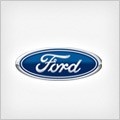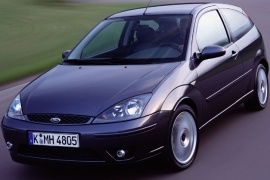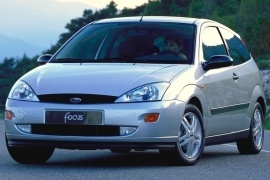
FORD Focus 3 Doors
Generations Timeline, Specs and Pictures

With the second generation of the Focus released in 2004, Ford had enough time to notice and improve the less good parts that came with the previous model.
Having the same basic structure, handling, comfort and safety remained the same, and by no means they needed improvement as the second generation sold really well mostly because of these.
However, the exterior design needed to be refreshed to bring the Focus up to date, as well as the interior getting updated with higher quality materials, a modern design and a better insulated cabin. The updates included a revised center stack, redesigned windows, redesigned mirrors switches, high quality leather for specific trim levels and for the Ghia and the Titanium models, Ford added a new woven headliner as standard.
Some of the optional features coming with the 2004 model became standard, such as the electronic stability control that came with every Ford Focus regardless of the trim level.
Technology was one of the main points Ford focused on improving, with the driver being able to connect and portable audio device via either a 3.5mm jack or a new USB port.
New for 2008, the Focus came with DAB (Digital Audio Broadcasting) paired with a high quality Sony audio system, thus clarity was highly enhanced.

The ST version of the Focus was meant to be a king among hot-hatches, but somehow it fell short behind its competitors.
Nevertheless, it was a quick, maneuverable hatchback.
After several sports cars, rally cars, and hot-hatches, Ford was one of the companies that knew how to build them. The Focus had all the necessary technical underpinnings to evolve into a successful street-performance vehicle, affordable enough to blast some of its competitors.
While the first hot-hatches were based exclusively on 3-doors bodyworks, Ford dared to offer its performance version with a three- and five-door version. But the favorite for the young and the restless teenagers was the three-door version, which looked more aggressive.
From the outside, the Focus ST featured a modified front bumper when compared to its regular siblings. The wider lower grille and the silver rims around the side-scoops, plus a specific radiator grille in the upper bumper area, made a difference between the ST and the regular version at the front. From the sides, the specific 18” light-alloy wheels helped the car handle better on the road. The arched roofline was ended in a tailgate-mounted roof-spoiler.
Inside, the Focus ST featured high-bolstered seats at the front to provide better support for its occupants. In the back, a split-folding seatback made room for more trunk space. For the dashboard, Ford installed a three-dials cluster with information regarding the boost, oil temperature, and oil pressure on top of the dashboard.
Under the hood, the Focus ST featured a 5-cylinder Volvo engine. Its 2.5-liter displacement with 20 valves and turbocharging provided 225 hp. It was mated as standard to a 6-speed manual gearbox.

The second-generation Ford Focus was unveiled in 2004 at the Paris Motor Show as a 3- and 5-door hatchback.
The sedan body style appeared in mid-2005.
The 3-door version had the sportiest appearance of them all, with the coupe-like swept roofline.
Also known as the MK 2 Focus, the new generation was built on the all-new C1 platform used by the Volvo S40, V50, C70, Mazda 3, and Ford C-Max, all part of Ford’s Global Shared Technologies program.
The most notable change was the car’s increased dimensions compared to the first generation Focus: 25 mm (0.98-inch) increase in wheelbase, 168 mm (6.6-inch) longer, 8 mm (0.31.inch) taller, and 138 mm (5.4-inch) wider. The update brought more interior room, as well as increased cargo capacity.
Inside, the new Focus came with high-quality plastics, dropping the inexpensive and bad looking ones used with the first generation. The central console was refreshed, looking better and similar to the Mondeo’s.
Besides the both inside and outside modern look, the new Focus featured some mechanical upgrades as well. The highly praised suspension design of the MK1 was carried over pretty much unchanged, and the 10% stiffer bodyshell had a positive effect on handling.
The new Focus could no longer be equipped with the Zetec-SE power units, as the Duratec family replaced them with the 1.6-liter Duratec Ti-VCT powerplant. The new unit was able to switch off valves to reduce fuel consumption. All units could be mated with the newly added Durashift transmissions: 6-speed manual or 4-speed automatic.
In terms of safety, the Ford Focus 2 managed to outpace most of its competitors, earning high scores at the EuroNCAP.

Along with the rest of the range, Ford introduced a facelifted version for its 3-door compact hatchback Focus in 2001.
The Focus didn’t seem so unusual after a few years on the market, and the customers started to return to Ford’s showrooms. The 2001 model was slightly reshaped to keep the new-edge designed vehicle up to date in Ford’s lineup.
The Focus was designed within the new-edge-design trend, which combined long, arched lines into sharp angles. It was a love-it or hate-it car that changed the perspective of many buyers. A set of new headlights was installed, with lenses for the headlights that improved the night-driving visibility. The turn-signals were moved from bumpers inside the headlights. On the lower apron, a wider grille was installed to increase the cooling capacity. The three-door version featured a triangular-shaped window behind the B-pillar. The ascending beltline amplified its sporty character.
Inside, the Focus kept the same unusual design that combined curved lines with sharp angles for the dashboard. Other than that, there was an improvement in the material’s quality, an area where some customers had some complaints. Unfortunately, the hood kept the same key-only opening mechanism, which required the driver to stop the engine, move the blue oval from the grille aside, insert the key, turn left and right and then pop the hood.
Apart from the hot-hatch ST version that offered 215 hp, the rest of the range shared the rest of the engines with the rest of its siblings.

Ford Focus was a true, love-it or hate-it car, due to its controversial look and the new-edge styling promoted by American brand with other vehicles such as Puma or Cougar.
In 1999, Ford stormed the Geneva Motor Show with the introduction of the Focus. It was one of the most awaited models for the European compact-segment and an important competitor for the Volkswagen Golf. The new design idea brought the car into attention and completed it with its engineering solutions.
The 3-door hatchback offered a dynamic look due to its long rear, side windows, and ascending beltline. At the front, the triangular-shaped headlight, with curved lines, emerged into sharp angles at the front, which was part of the new-edge-design philosophy. An arched roofline ended into a curved, sloped tailgate was a step forward than its competitors. Its taillights were mounted high on the D-pillars, being protected from small dents in the parking lots.
Inside, the new-edge-design language was continued on the dashboard. The upper lines of the instrument cluster emerged in sharp angles with the rest of the panel. Its rear seats offered good legroom and headroom. Due to the rear independent suspension, the trunk was not the biggest in its class, but that layout was needed to increase comfort.
Ford installed a wide choice of diesel and gasoline engines, which was paired as standard with a 5-speed manual gearbox. A 4-speed automatic was on the options list for specific engines. Due to its independent suspension in all corners, the Focus was a benchmark in its car-segment for the cornering speed.























































